Understand How Einstein Next Best Action Works
Learning Objectives
After completing this unit, you’ll be able to:
- Understand how Einstein Next Best Action fits into the Einstein Platform family.
- Explain the different components that make up Einstein Next Best Action.
- Set up and deploy recommendations to your employees or customers.
Introduction
Einstein Next Best Action is part of the family of products within the Einstein Platform—a platform that helps admins and developers build their own AI-powered assistants for a wide array of use cases. You can use point-and-click and programmatic functionality to build applications that predict anything surfaced through Salesforce.
To set up Einstein Next Best Action, follow these simple steps:
- Define a set of recommendations.
- Create action strategies.
- Integrate predictive models (optional).
- Display recommendations.
- Activate automation.
In this unit, we highlight each step for setting up Einstein Next Best Action so you can be successful in your implementation. While this module is a great overview, refer to the documentation found in the Resources section—it dives a little deeper into the setup process.
Imagine that you’re a Salesforce Admin at a telecommunications company. You should first pick one target persona that you want to create recommendations for, and then expand to more use cases and users. The persona we want to create recommendations for is a sales rep. They are the first line of contact for all of the company’s customers, answering customer questions, routing cases to customer support, and selling new products or services at the right time.
One major area of focus this year is upsell or cross-sell to customers, but it’s difficult for each rep to instantly know which products or services to offer. Currently, when a customer calls, the rep pulls up their contact page, answers any questions they have, and simultaneously scans the page to see what they’ve bought, where they live, and what previous interactions they’ve had with the company. A big opportunity is to offer customers who already have Internet service our new TV streaming service. It takes too much time to see if the customer has Internet and doesn’t have TV streaming, offer it on the phone, package up the offer, and manually kick off the service.
Define Your Recommendations
Let’s look at how we can create recommendations to our reps to offer their customers the TV streaming service.
- Click App Launcher.
- Scroll down and click Recommendations.
- On the top right-hand side, click New.
- Enter a Name and Description.
- Upload an image.
- Enter Acceptance and Rejection Labels.
- Add an Action you want to link it to if the user accepts.

Create Action Strategies
Think of action strategies as the decisioning brain. Action strategies let you load all of your recommendations and constantly evaluate them based on your business rules to determine which ones to surface to your users. You can create action strategies for different users and departments, such as your call center, inside sales department, or French-language website.
Let’s take a look at how to create a new strategy.
- Click Setup.
- Enter
Next Best Actionin the Quick Find box and select Next Best Action. - Click New Strategy.

- Enter the Name, API Name, and Description.
- Define the Object Where Recommendations Display (that is, if you want to display them on contact records, accounts, cases, and so on).
Once your action strategy is created, you’re taken to the Strategy Builder to populate it. Here’s a great example of our action strategy for the telecom example.
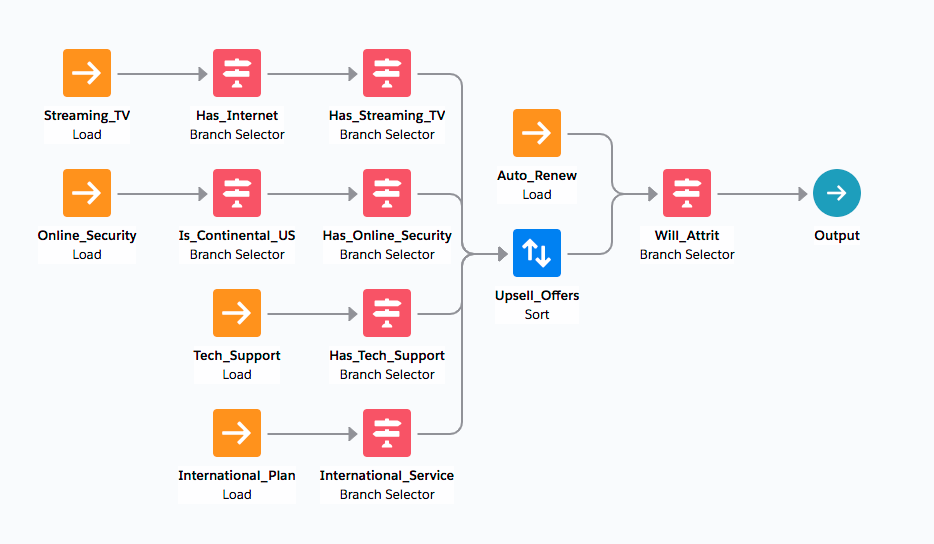
Action strategies convey recommendations flowing from left to right, getting cut off as they move to the right along the branches, leaving only the ones that remain on the far right. Each element on the Strategy Builder is referred to as a node. The yellow nodes are for recommendations. The blue nodes are for filtering and sorting recommendations. The pink nodes are for filtering branch logic. Finally, all the way on the right is the teal node which represents the winning recommendation that will surface.
Check out the branch with our TV streaming recommendation example, and disregard all other branches for now.
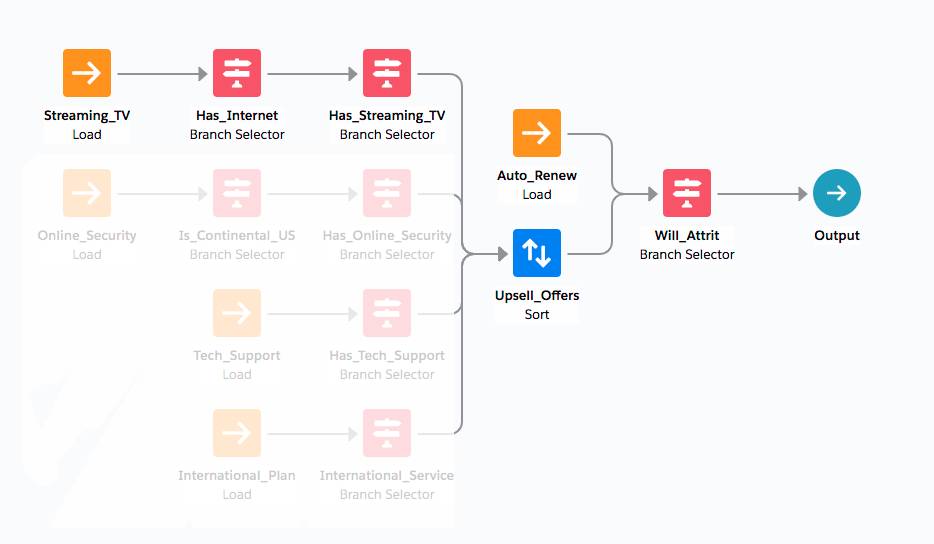
If you double-click the pink node (Has_Internet), you can see that it filters through contacts who have the Internet_Service record checked. This means they have Internet service and can be upsold the TV stream service.
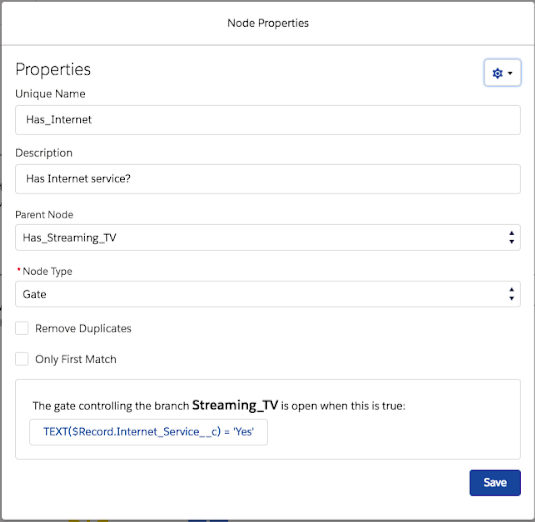
The next pink node on the right (Has_Streaming_TV) filters out contacts who already have TV streaming service.
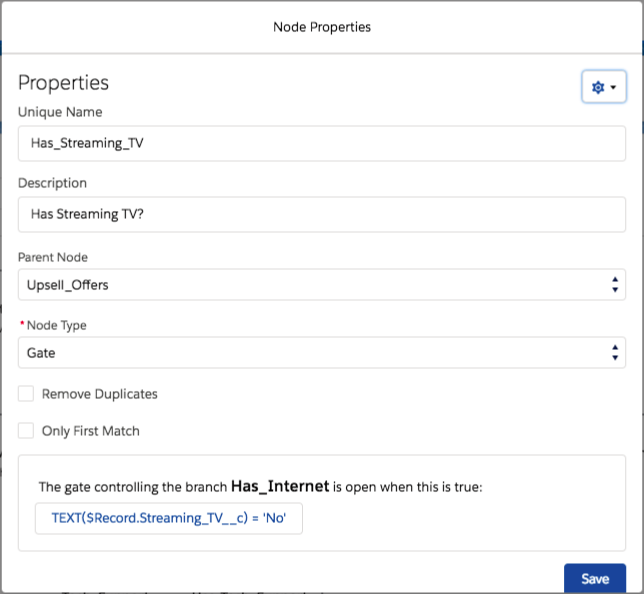
For the rest of the action strategy, we created a few upsell recommendations and branches.
- Online security—for contacts in the continental US who don’t have online security.
- Tech support—for contacts who don’t already have tech support.
- International plan—for international customers.
We then bucketed those recommendations into Upsell Offers and sorted the recommendations in alphabetical order so there is a hierarchy of recommendations for each contact.
Inject Intelligence into Action Strategies
Our telecommunications company has had a huge problem with customer attrition. We used Einstein Prediction Builder to help us figure out that customers were leaving for a number of reasons—payment methods, monthly charge amount, length of time as a customer, and more. As a sales rep, you can’t possibly pay attention to all of these factors for each customer, so Einstein Prediction Builder scored the likelihood of attrition for each.
But a prediction only goes so far. You need a recommendation or action to follow that prediction. In this case, we’ve found success by offering customers who have a high likelihood of attrition a discounted auto-renew plan.
Recall our action strategy for telecommunications sales reps. The next node, Will_Attrit, is where intelligence from Einstein Prediction Builder is injected. It takes in the prediction field created (Likelihood_of_Attrition), and if that likelihood is greater than or equal to 20%, the auto-renew recommendation becomes the winning recommendation that surfaces on the contact page. If the likelihood of attrition is lower, upsell recommendations win.

Display Recommendations
Now that you have defined your recommendations and set up your action strategy, you need to display the recommendations on the appropriate page. Recommendations can be embedded into any digital touchpoint: chatbots, community portals, web pages, backend systems, Salesforce objects and records, and mobile devices. In this case, since we want recommendations for each contact, we’re going to display the recommendations on contact pages.
In order to display recommendations, you need the Lightning App Builder. To use it, go to a contact page, click Setup, then click Edit Page.
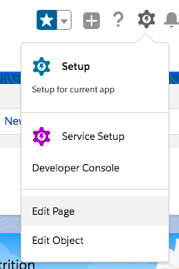
Now you’re in the Lightning App Builder. Click the Einstein Next Best Action Lightning component on the left and drag it wherever you want on the page. If you already have an Einstein Prediction Builder component on the page, we suggest placing the Einstein Next Best Action component right under that one. Click Save and you’re done!
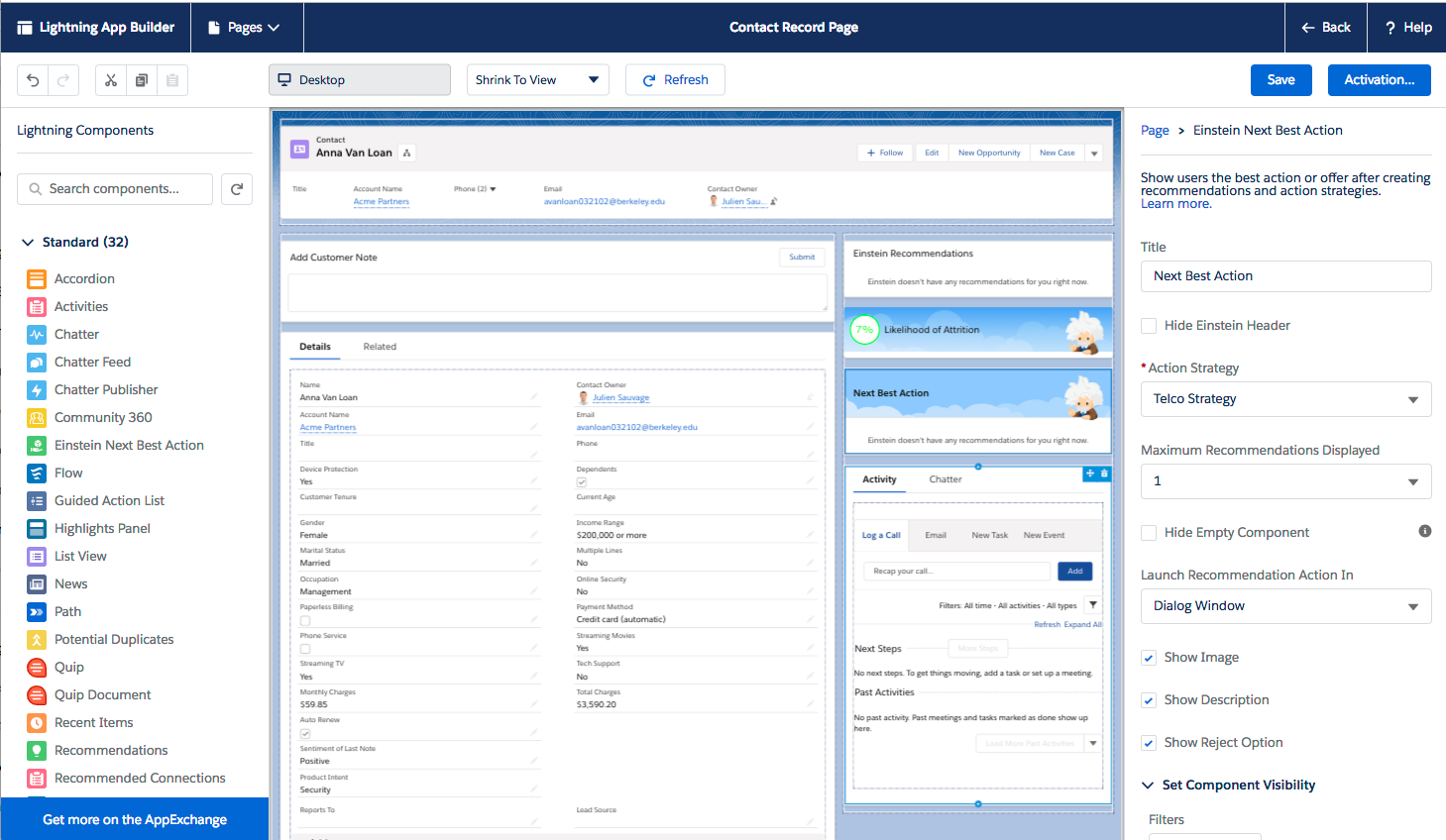
Activate Automation
That’s it! From an Admin standpoint, everything is set up.
The last step in this process is for the user to accept the recommendation. Revisiting our hypothetical example, let’s say Anna Van Loan wants to auto-renew. When you click Accept in the recommendation, a confirmation email is automatically sent to Anna. Once she accepts, the Auto-Renew field on her contact record is automatically checked and she is enrolled in the offer. After reloading the page, the Einstein Prediction Builder likelihood of attrition prediction has dropped to 7% and upsell recommendations are now displayed.
Congrats! You’ve learned how to create and display offers and actions for your users and used business logic and predictive models to refine those recommendations with Einstein Next Best Action.
